What to do if there is water in the well: causes of problems
Why is water gone in the well? Is it possible to reanimate it? In the article we will try to find answers to these questions and give a number of additional tips on the most long and trouble-free operation of wells.
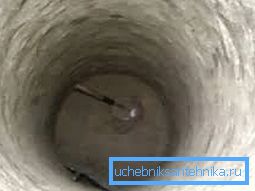
The reasons
So, the water level in the well dropped catastrophically. At the bottom splashing shallow muddy puddle.
What could be causing this disaster?
- Silting The aquifer, first of all - the upper one, does not always carry clean water. Fine sand and clay particles fall into the well and gradually settle at the bottom, reducing the height difference between the bottom of the well and the water mirror. What is even sadder is that the sediments significantly reduce the flow rate of the well, preventing filtration.
By the way: diaphragm pumps speed up silting with their vibration. Centrifugal and surface devices in this plan are far more harmless.
- Seasonal drop in water level. In severe frosts or after a long drought, groundwater often recedes by one to two meters.
- The depletion of the aquifer excess flow through numerous wells and boreholes. If consumption exceeds flow rate, the result will be quite predictable.
- Advances or blurring of water-impermeable layers, meaning the complete withdrawal of an aquifer to a greater depth.

Solutions
Silting
If the bucket is capable of scooping from the bottom only dirty muck, and the water mirror has not lowered relative to the usual level - the conclusions are obvious: the well needs cleaning.
The simplest method has not changed in recent centuries. The brave hero of a subtle physique is armed with a pair of buckets, a scoop and descends into the abyss along a rope. After several hours of tedious and dirty work, the owner of the well celebrates the victory.
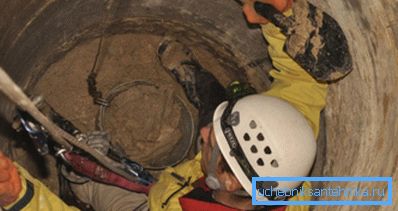
Jokes jokes, and the way is really quite dangerous.
What exactly?
- Viscous sodden clay can suck a person so deep that pulling it out with a rope around it will be very problematic.
- The drawdown of the rings due to the swollen base is quite capable of burying the well along with the one who cleans it.
Is there a safer way to remove sludge?
Sure. However, for its implementation - here is a paradox! - you need a large amount of at least relatively clean water.
The essence of the method is in the smearing of silt by a powerful jet:
- Water flows directly to the bottom under high pressure.
- At the same time, it is pumped out and dumped to the ground at a distance with an ordinary faecal pump.
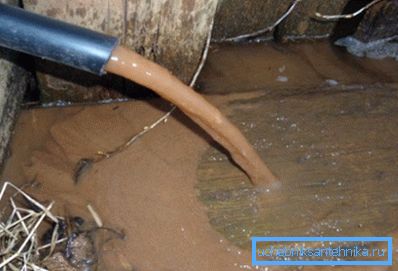
After cleaning the well several times completely pumped out. Thus, the remnants of the sludge are removed from the bottom and the adjacent part of the aquifer.
Seasonal level drop
What to do if after a few weeks of drought the water in the well disappeared?
The obvious answer is to wait. Obvious, but not always satisfactory: when the well is the only source of fresh water, a long wait, pardon the involuntary pun, it smells bad. A more sensible solution is to try to increase the depth of the well.
In this case, to do the work, being on the surface, obviously will not work.
- In this case, a fecal or drainage pump is also put on pumping.
Useful: these two types of pumps differ only in their ability to cope with large fractional pollution. A fecal pump is capable of crushing soft clay lumps and pumping them along with water; drainage can cope only with suspensions.
- After removing the bulk of the water in the bottom, a shallow pit comes off. The pump migrates into it, thereby allowing to take out a relatively dry soil. With the deepening of the bottom comes off deeper and pit.
- Next - a long epic with the participation of picks, shovels and a pair of buckets.
How to strengthen the walls of the deep well? As a rule, the so-called repair rings having a smaller diameter in comparison with the main shaft are lowered into them.
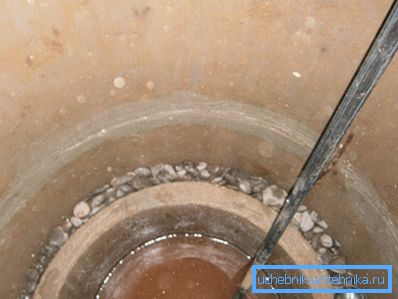
Aquifer depletion
Half measure - an attempt again to deepen the well, lowering its bottom below the fallen level of groundwater. Why half measure? Yes, because after you deepen the well, the neighbors left without water will do the same. History will return to its beginning.
A radical solution is the drilling of an artesian well (on limestone, down to the lower aquifer). The debit of the lower horizons, as a rule, is much harder to exhaust.
Alas, this work is almost impossible to do with your own hands: a drill string 50-60 meters high in stone, even if it is sedimentary rocks, simply cannot be turned. The price of a running meter of a borehole during machine drilling varies from about 1,700 to 3,000 rubles.

It is clear that deep drilling is the only way out even with the destruction of an impermeable formation under aquifer sand. To deepen the well for a couple of tens of meters with a dubious result is a strange idea.
Useful stuff
Finally, let us give the reader a few unsystematic tips on caring for a well.
Suddenly something is useful
- Before deepening the well, it is better to drill into its bottom with a usual garden auger a couple of meters away. What is the reason for this instruction? It's simple: if you take out the dry soil - further digging will be useless, the water is gone.
- The water becomes dirty not only because of the silting of the bottom, but also because of the displacement of the rings. After that, rainwater and soil eroded into it begin to enter the mine.
Repair of the well in this case comes down to the installation of a thick perforated plastic pipe into its shaft. The gap between the walls is filled with sand, screening or fine gravel.
- Full pumping is best done at least once a year, even if the water level does not fall. You will not only remove sludge accumulated at the bottom: when the water level in the well drops, the flow of water in the aquifer sharply accelerates. Washing will remove the suspended sediment and is likely to increase the flow rate.
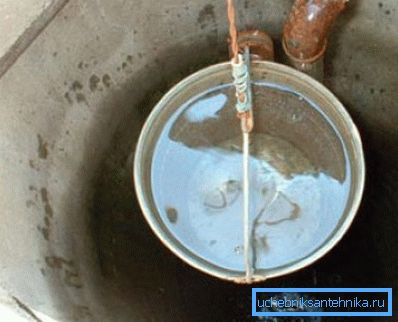
Conclusion
If some moments were not clear to the reader, perhaps he will find the answers in the video in this article. Successes!